Differences in Mesozoic–Cenozoic Structural Deformation Between the Northern and Southern Parts of the East China Sea Shelf Basin and Their Dynamic Mechanisms
Abstract
1. Introduction
2. Tectonic Setting
3. Geophysical Data and Method
4. Results
4.1. Gravity Anomaly
4.2. Magnetic Anomaly
4.3. Differences in Basin Structural Deformation
4.4. Differences in Deep Geological Structure
5. Discussion
5.1. The Control Effect of the Strength of Deep Crust–Mantle Activity on the Differences in Geological Structure Between the North and South of the ECSSB
5.2. Differences in the Tectono-Sedimentary Patterns of the Basins Between the North and South Caused by the Multi-Stage Amalgamation of the Yangtze–Cathaysia Blocks
5.3. The Controlling Effect of Plate Subduction and Deep NW Faults on the Differences in Tectonic Deformation Between the North and South of the ECCSB
6. Conclusions
- The southern and northern ECSSB have significantly different Meso-Cenozoic basin structures. The southern part is a large Meso-Cenozoic fault sag superimposed basin, with widely distributed and thick Meso-Cenozoic strata that have developed. The northern ECSSB is a fault sag basin dominated by the Cenozoic. The thickness of the Cenozoic strata in the Xihu sag can reach up to 15 km, and multiple periods of structural inversion have developed.
- Compared with the northern part of the basin, the southern part of the basin has a greater number and larger scale of NW-trending deep faults. Meanwhile, the southern ECSSB is more significantly affected by deep magmatic activities, and igneous rocks are also more developed. It is obvious that there is a good response relationship between the distribution of faults and the development of igneous rocks. It is worth noting that the seismic profile has revealed deep NW faults that developed in the central basin, namely, the Yushan–Kume fault and Zhoushan–Kunigami fault, speculated on by previous researchers based on gravity and magnetic data.
- During the pre-Mesozoic, mantle upwelling caused thermal uplift of the lithosphere in the southern ECSSB. Later, the subduction of the Paleo-Pacific Plate weakened or interrupted the supply of heat sources, resulting in cooling and contraction of the lithosphere and thermal subsidence, laying the foundation for the formation of the Mesozoic sag basin in ancient landforms. In contrast, the northern ECSSB experienced no lithospheric thermal doming because deep crust–mantle activity remained relatively stable. Extensional faulting did not commence until the late Cretaceous, ultimately producing a basin architecture markedly different from that of the southern basin.
- During the Cenozoic, the ECSSB experienced complex subduction of the Pacific Plate, with varying directions and rates of subduction, resulting in different tectonic stresses in the basin during different geological periods. At the same time, the deep NW faults widely developed in the basin played a key tuning and transformation role in the subduction compression mentioned above, resulting in significant differences in structural deformation in different geological periods within various structural units in the southern and northern ECSSB.
Author Contributions
Funding
Data Availability Statement
Conflicts of Interest
References
- Li, S.; Suo, Y.; Li, X.; Zhou, J.; Santosh, M.; Wang, P.; Wang, G.; Guo, L.; Yu, S.; Lan, H.; et al. Mesozoic tectono-magmatic response in the East Asian ocean-continent connection zone to subduction of the Paleo-Pacific Plate. Earth-Sci. Rev. 2019, 192, 91–137. [Google Scholar] [CrossRef]
- Zhu, W.L.; Zhong, K.; Fu, X.W.; Chen, C.F.; Zhang, M.Q.; Gao, S.L. The formation and evolution of the East China Sea Shelf Basin: A new view. Earth-Sci. Rev. 2019, 190, 89–111. [Google Scholar] [CrossRef]
- Cheng, Y.J.; Wu, Z.P.; Zhang, J.; Liu, Y.Q.; Dai, Y.N. Cenozoic tectonic evolution of offshore Chinese Basins and its response to geodynamic processes of the East Asian Continental Margin. Earth-Sci. Rev. 2022, 232, 104–140. [Google Scholar] [CrossRef]
- Zhao, J.H. The forming factors and evolvement of the Mesozoic and Cenozoic vasin in the East China Sea. Mar. Pet. 2004, 24, 6–14, (In Chinese with English abstract). [Google Scholar]
- Suo, Y.H.; Li, S.Z.; Yu, S.; Somerville, L.D.; Liu, X.; Zhao, S.J.; Dai, L.M. Cenozoic tectonic jumping and implications for hydrocarbon accumulation in basins in the East Asia Continental Margin. J. Asian Earth Sci. 2014, 88, 28–40. [Google Scholar] [CrossRef]
- Wei, X.; Ding, W.; Christeson, G.L.; Li, J.; Ruan, A.; Niu, X.; Zhang, J.; Zhang, Y.; Tan, P.; Wu, Z.; et al. Mesozoic suture zone in the East China Sea: Evidence from wide-angle seismic profiles. Tectonophysics 2021, 820, 229116. [Google Scholar] [CrossRef]
- Fu, X.; Ding, W.; Dadd, K.; Li, J.; Zhu, W.; Feng, K.; Geng, J.; Xu, X. An exotic origin of the eastern East China Sea basement before ∼150 Ma. Sci. Bull. 2022, 67, 1939–1942. [Google Scholar] [CrossRef]
- Xu, B.; Wu, Z.P.; Cheng, Y.J.; Miocic, J.M.; Dai, Y.N.; Chu, Y.C. Cenozoic structural and tectonic evolution in the Western Xihu Basin, East China Sea Shelf Basin. Int. J. Earth Sci. 2024, 113, 713–732. [Google Scholar] [CrossRef]
- Yang, Y.Q.; Yang, C.Q.; Yang, C.S.; Sun, J. Mesozoic fault system in the Southern East China Sea Shelf Basin and its bearing on basin structures. Mar. Geol. Quat. Geol. 2019, 39, 52–61. [Google Scholar] [CrossRef]
- Yang, C.; Yang, C.; Yang, Y.; Sun, J.; Wang, J.; Xiao, G.; Wang, J.; Yuan, Y. Deep stratigraphic framework and hydrocarbon resource potential in the Southern East China Sea Shelf Basin. Mar. Geol. Quat. Geol. 2022, 42, 158–171. [Google Scholar]
- Li, S.; Zhao, G.; Dai, L.; Zhou, L.; Liu, X.; Suo, Y.; Santosh, M. Cenozoic faulting of the Bohai Bay Basin and its bearing on the destruction of the eastern North China Craton. J. Asian Earth Sci. 2012, 47, 80–93. [Google Scholar] [CrossRef]
- Zhang, G.; Anlin, G.; Wang, Y.; Li, S.; Dong, Y.; Liu, S.; He, D.; Cheng, S.; Lu, R.; Yao, A. Tectonics of South China Continent and its implications. Sci. China Earth Sci. 2013, 56, 1804–1828. [Google Scholar] [CrossRef]
- Hall, R. Cenozoic geological and plate tectonic evolution of SE Asia and the SW Pacific: Computer-based reconstructions, model and animations. J. Asian Earth Sci. 2002, 20, 353–431. [Google Scholar] [CrossRef]
- Jiang, W.; Song, H.; Hao, T.Y.; Liu, S. The characters of geology and geophysics of shell basins of East China Sea and adjacent sea area. Prog. Geophys. 2001, 16, 18–27. [Google Scholar]
- Hao, T.Y.; Xu, Y.; Xu, Y.; Mancheol, S.; Liu, J.H.; Dai, M.; Li, Z. Some new understandings on deep structure in Yellow Sea and East China Sea. Chin. J. Geophys. 2006, 49, 458–468. [Google Scholar] [CrossRef]
- Zheng, Q.G.; Zhou, Z.; Cai, L.; Lu, Y.; Cao, Q. Meso-Cenozoic tectonic setting and evolution of East China Sea shelf basin. Oil Gas Geol. 2005, 26, 197–201. [Google Scholar]
- Cukur, D.; Horozal, S.; Lee, G.H.; Kim, D.C.; Han, H.C.; Kang, M.H. Structural evolution of the northern East China Sea Shelf Basin interpreted from cross-section restoration. Mar. Geophys. Res. 2011, 32, 363–381. [Google Scholar] [CrossRef]
- Zhou, X.M.; Li, W.X. Origin of Late Mesozoic igneous rocks in Southeastern China: Implications for lithosphere subduction and underplating of maficb magmas. Tectonophysics 2000, 326, 269–287. [Google Scholar] [CrossRef]
- Yang, C.; Li, G.; Luan, X.; Yang, C.; Gong, J.; Yanqiu, Y.; Suo, Y. Geophysical Interpretation and Formation Mechanism of the Yandang Low Uplift in the East China Sea Shelf Basin. Chin. J. Geophys. 2014, 57, 650–662. [Google Scholar] [CrossRef]
- Li, J. Geology of the East China Sea Region; China Ocean Press: Beijing, China, 2008. [Google Scholar]
- Zhang, X.H.; Zhang, G.W. Continuously striving to create brilliance—Review and Prospect of Two Journals of Marine Geology. Mar. Geol. Quat. Geol. 2008, 28, 34–56+78. [Google Scholar]
- Yang, C.S.; Li, S.Z.; Li, G.; Yang, C.Q.; Yang, Y.Q.; Dai, L.M.; Suo, Y.H.; Li, Q.; Jiang, Y.B. Tectonic units and proto-basin of the East China Sea Shelf Basin: Correlation to Mesozoic subduction of the Palaeo-Pacific Plate. Geol. J. 2016, 51, 149–161. [Google Scholar] [CrossRef]
- Suo, Y.H.; Li, S.Z.; Cao, X.Z.; Wang, X.Y.; Somerville, I.; Wang, G.Z.; Wang, P.C.; Liu, B. Mesozoic-Cenozoic basin inversion and geodynamics in East China: A review. Earth-Sci. Rev. 2020, 210, 103357. [Google Scholar] [CrossRef]
- Han, B.; Zhang, X.H.; Pei, J.X.; Zhang, W.G. Characteristics of crust-mantle in East China sea and adj acent regions. Prog. Geophys. 2007, 22, 376–382, (In Chinese with English abstract). [Google Scholar] [CrossRef]
- Zhang, H.; Zhang, X.; Wen, Z.; Lan, X. Geological and Geophysical Series Maps of Eastern China Sea Area and Neighborhood; China Ocean Press: Beijing, China, 2011. [Google Scholar]
- Shang, L.N.; Zhang, X.H.; Jia, Y.G.; Han, B.; Yang, C.S.; Geng, W.; Pang, Y.M. Late Cenozoic evolution of the East China continental margin: Insights from seismic, gravity, and magnetic analyses. Tectonophysics 2017, 698, 1–15. [Google Scholar] [CrossRef]
- Cukur, D.; Senay, H.; Dae, C.K.; Gwang, H.L.; Hyun, C.H.; Moo, H.K. The distribution and characteristics of the igneous complexes in the northern East China Sea Shelf Basin and their implications for hydrocarbon potential. Mar. Geophys. Res. 2010, 31, 299–313. [Google Scholar] [CrossRef]
- Yao, Z.; Li, C.-F.; He, G.; Tao, T.; Zheng, X.; Zhang, T.; Tang, X.; Zhao, T. Cenozoic sill intrusion in the central and southern East China Sea Shelf Basin. Mar. Pet. Geol. 2020, 119, 104465. [Google Scholar] [CrossRef]
- Li, N. Preliminary study on the transverse fault of the Okinawa Trough. Acta Oceanol. Sin. 1990, 4, 455–462. [Google Scholar]
- Zhang, S.; Zhang, J.; Tang, X.; Zhang, T. Geometry characteristic of the fault system in Xihu sag in East China Sea and its formation mechanism. Mar. Geol. Quat. Geol. 2014, 34, 87–94. [Google Scholar] [CrossRef]
- Lin, J.; Sibuet, J.; Hsu, S. Distribution of the East China Sea continental shelf basins and depths of magnetic sources. Earth Planets Space 2005, 57, 1063–1072. [Google Scholar] [CrossRef]
- Hu, M.Y.; Li, S.Z.; Dai, L.M.; Suo, Y.H.; Guo, L.L.; Liu, Z.; Ma, F.F.; Tao, J.L. Numerical dynamic modeling of tectonic inversion in the northeastern Xihu Sag. Mar. Geol. Quat. Geol. 2017, 37, 151–166. [Google Scholar] [CrossRef]
- Xu, H.Z.; Wei, F.S.; De, W.Q.; Yun, L.; Bo, C.Z.; Chun, M.L.; Xi, Y.W. Age dating of Paleocene Meirenfeng Formation and its significance for the hydrocarbon source rocks in the East China Sea basin. Mar. Pet. Geol. 2024, 160, 106663. [Google Scholar] [CrossRef]
- Zhao, L.H.; Li, Y.Q.; Liu, X.Y.; Zheng, Y.P.; Zhao, Q.; Liu, K.; Zhi, P.Y. Deep seismic phases and crustal structure in the East China Sea shelf. Acta Sci. Nat. Univ. Sunyatseni 2022, 61, 84–93, (In Chinese with English abstract). [Google Scholar]
- Yang, C.; Yang, C.; Shang, L.; Yan, Z.; Yang, Y. Discovery of Late Cretaceous-Paleocene faulted basins developed on the Yandang Low Uplift, East China Sea Shelf Basin. China Geol. 2019, 2, 243–244. [Google Scholar] [CrossRef]
- Yang, C.; Han, B.; Yang, C.; Yang, Y.; Sun, J.; Yu, F. Mesozoic basin evolution of the East China Sea Shelf and tectonic system transition in Southeast China. Geol. J. 2020, 55, 239–252. [Google Scholar] [CrossRef]
- Qi, J.; Zhang, X.; Wu, Z.; Meng, X.; Shang, L.; Li, Y.; Guo, X.; Hou, F.; He, E.; Wang, Q. Characteristics of crustal variation and extensional break-up in the Western Pacific back-arc region based on a wide-angle seismic profile. Geosci. Front. 2021, 12, 101082. [Google Scholar] [CrossRef]
- Li, X.; Guo, K.; Li, S.; Yang, H.; Pi, J.; Zhong, Y.; Chen, L.; Suo, Y.; Stern, R.J.; Wang, X.; et al. Arc magma heterogeneity induced by subslab mantle upwelling. Geology 2024, 52, 870–874. [Google Scholar] [CrossRef]
- Yu, H.S.; Jinder, C. Cenozoic basins in northern Taiwan and tectonic implications for the development of the eastern Asian continental margin. Palaeogeogr. Palaeoclimatol. Palaeoecol. 1997, 131, 133–144. [Google Scholar] [CrossRef]
- Morley, C.K. Late Cretaceous–Early Palaeogene tectonic development of SE Asia. Earth-Sci. Rev. 2012, 115, 37–75. [Google Scholar] [CrossRef]
- Xu, J.Y.; Zvi, B.A.; Tom, K.; Ho, S.Y. Origin of marginal basins of the NW Pacific and their plate tectonic reconstructions. Earth-Sci. Rev. 2014, 130, 154–196. [Google Scholar] [CrossRef]
- Qi, J.H.; Wu, Z.Q.; Zhang, X.H.; Wen, Z.H.; Meng, X.J.; Shang, L.N.; Hou, F.H.; Hu, G. Deep Seismic Evidence of Cenozoic Tectonic Migration in the Western Pacific Back-Arc Area. Earth Sci.-J. China Univ. Geosci. 2020, 45, 2495–2507, (In Chinese with English abstract). [Google Scholar]
- Zhou, X.; Zhang, H. Highly Chemical Heterogeneity of Subcontinental Lithosphere Mantle beneath North China and its Major Transformation. Earth Sci. Front. 2006, 31, 8–13. [Google Scholar]
- Liu, Z.; Dai, L.M.; Li, S.Z.; Guo, L.L.; Hu, M.Y.; Ma, F.F.; Tao, J.L.; Yang, C.Q.; Suo, Y.H. Mesozoic magmatic activity and tectonic evolution in the southern East China Sea Continental Shelf Basin: Thermo-mechanical modelling. Geol. J. 2017, 53, 240–251. [Google Scholar] [CrossRef]
- Niu, Y. Generation and Evolution of Basaltic Magmas: Some Basic Concepts and a New View on the Origin of Mesozoic-Cenozoic Basaltic Volcanism in Eastern China. Geol. J. China Univ. 2005, 11, 9–46. [Google Scholar]
- Li, X.; Li, W.; Li, Z.; Lo, C.; Wang, J.; Ye, M.; Yang, Y. Amalgamation between the Yangtze and Cathaysia Blocks in South China: Constraints from SHRIMP U–Pb zircon ages, geochemistry and Nd–Hf isotopes of the Shuangxiwu volcanic rocks. Precambrian Res. 2009, 174, 117–128. [Google Scholar] [CrossRef]
- Wang, L.; Lin, S.; Xiao, W. Yangtze and Cathaysia blocks of South China: Their separate positions in Gondwana until early Paleozoic juxtaposition. Geology 2023, 51, 723–727. [Google Scholar] [CrossRef]
- Dong, Y.; Hui, B.; Sun, S.; He, D.; Sun, J.; Zhang, F.; Cheng, C.; Yang, Z.; Shi, X.; Zang, R.; et al. Neoproterozoic tectonic evolution and proto-basin of the Yangtze Block, China. Earth-Sci. Rev. 2024, 249, 104669. [Google Scholar] [CrossRef]
- Zhang, G.W.; Guo, A.L.; Wang, Y.J.; Li, S.Z.; Dong, Y.; Liu, S.F.; He, D.F.; Cheng, S.Y.; Lu, R.K.; Yao, A.P. The Structure and Problems of the South China Continent in China. Sci. Sin. (Terrae) 2013, 43, 1553–1582. [Google Scholar]
- Guo, L.H.; Gao, R.; Zhang, J.; Xiong, X. The Neoproterozoic Yangtze—Huaxia Block Fusion Belt: Insights from the South China Gravity and Magnetic Anomalies. Chin. J. Geol. (Sci. Geol. Sin.) 2016, 51, 682–693. [Google Scholar]
- Han, B.; Zhang, X.H.; Yang, J.; Pei, J. The multiple-height analytical continuation in processing the gravity anomaly data from the East China Sea and adjacent regions. Chin. High Technol. Lett. 2007, 17, 1272–1277. [Google Scholar]
- Zhong, G.; Su, P.; Feng, C.; Liu, S.; Sun, M.; Yi, H.; Zhao, J.; Zhao, Z. Mesozoic tectonic characteristics and exploration prospects of the Chaoshan depression in the northeastern South China Sea. Acta Geol. Sin. 2022, 96, 2896–2905. [Google Scholar]
- Li, S.; Suo, Y.; Li, X.; Wang, Y.; Cao, X.; Wang, P.; Guo, L.; Yu, S.; Lan, H.; Li, S.; et al. Mesozoic plate subduction in West Pacific and tectono-magmatic response in the East Asian ocean-continent connection zone. Chin. Sci. Bull. 2018, 63, 1550–1593. [Google Scholar] [CrossRef]
- Zhu, W.L.; Xu, X.H.; Wang, B.; Cao, Q.; Chen, C.F.; Gao, S.L.; Feng, K.L.; Fu, X.W. Late Mesozoic continental arc migration in southern China and its effects on the evolution of offshore forearc basins. Earth Sci. Front. 2022, 29, 277–290. [Google Scholar] [CrossRef]
- Zhang, Q. Is the Mesozoic magmatism in eastern China related to the westward subduction of the Pacific plate? Acta Petrol. Mineral. 2013, 32, 113–128. [Google Scholar]
- Seton, M.; Flament, N.; Whittaker, J.; Müller, R.D.; Gurnis, M.; Bower, D.J. Ridge subduction sparked reorganization of the Pacific plate-mantle system 60–50 million years ago. Geophys. Res. Lett. 2015, 42, 1732–1740. [Google Scholar] [CrossRef]
- Ma, Q.; Xu, Y.G. Magmatic perspective on subduction of Paleo-Pacific plate and initiation of big mantle wedge in East Asia. Earth-Sci. Rev. 2021, 213, 103473. [Google Scholar] [CrossRef]
- Wei, J.; Dai, S.; Cheng, H.; Wang, H.; Wang, P.; Li, F.; Xie, Z.; Zhu, R. Review of Asymmetric Seafloor Spreading and Oceanic Ridge Jumps in the South China Sea. J. Mar. Sci. Eng. 2024, 12, 408. [Google Scholar] [CrossRef]
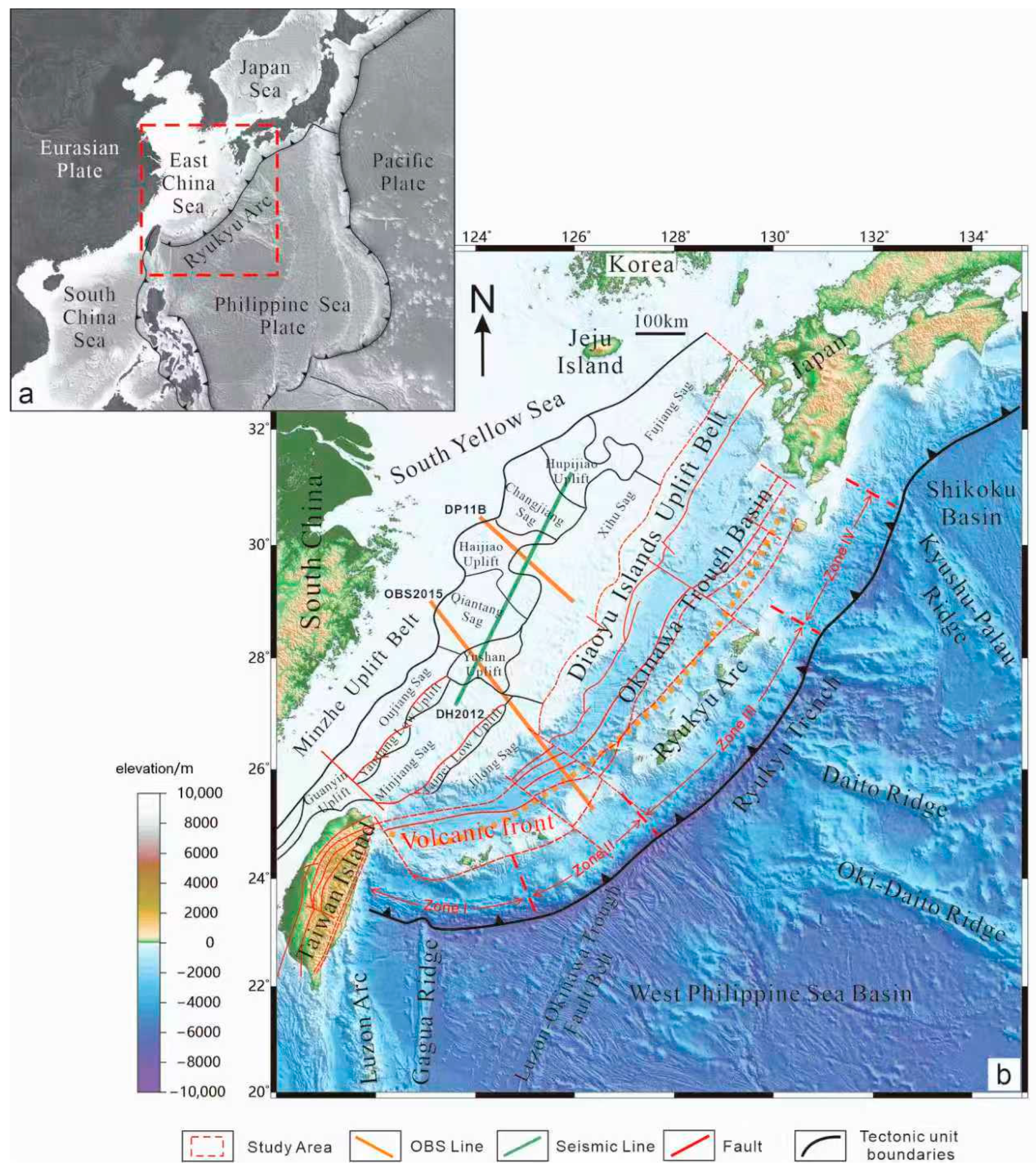
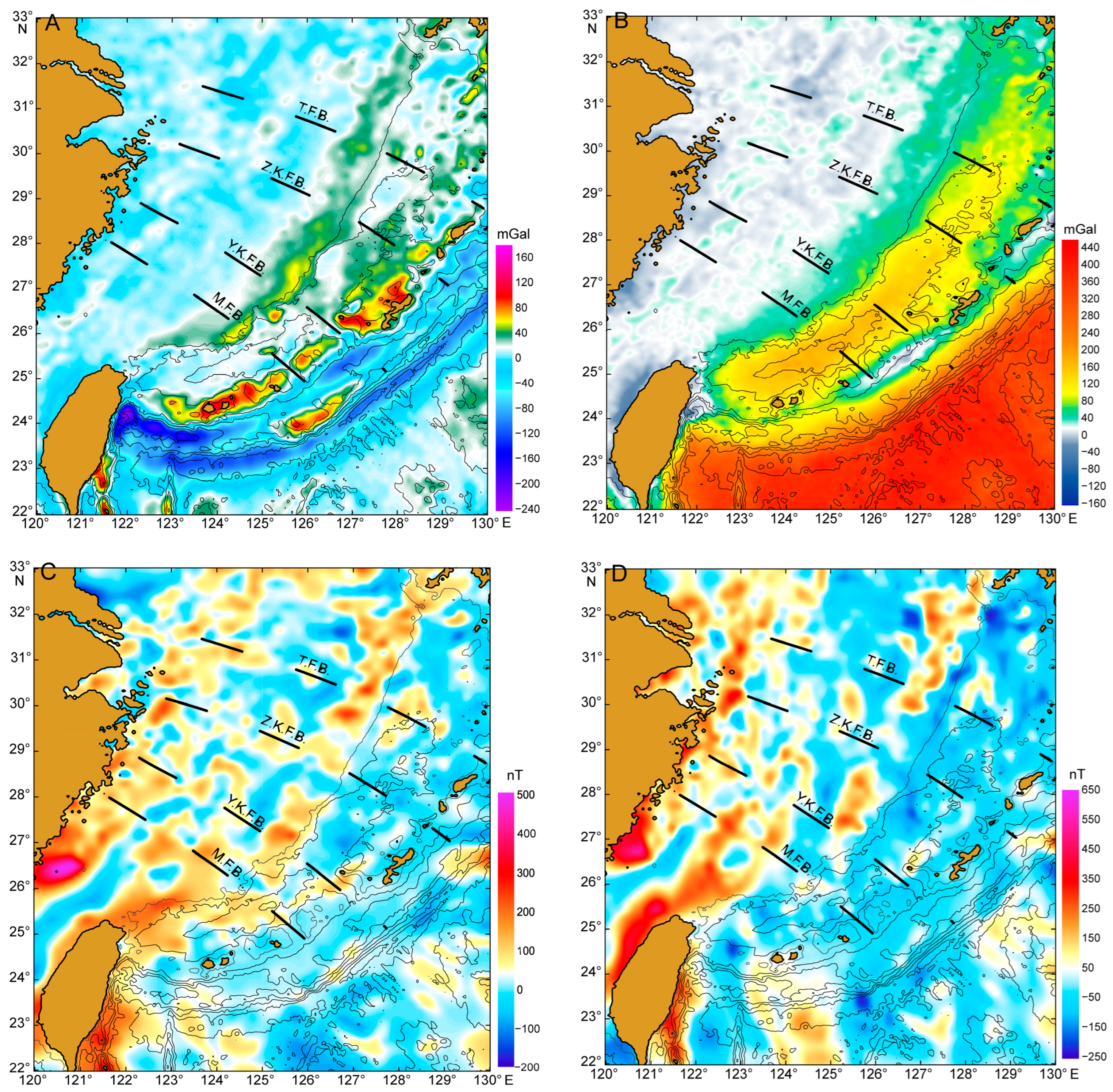

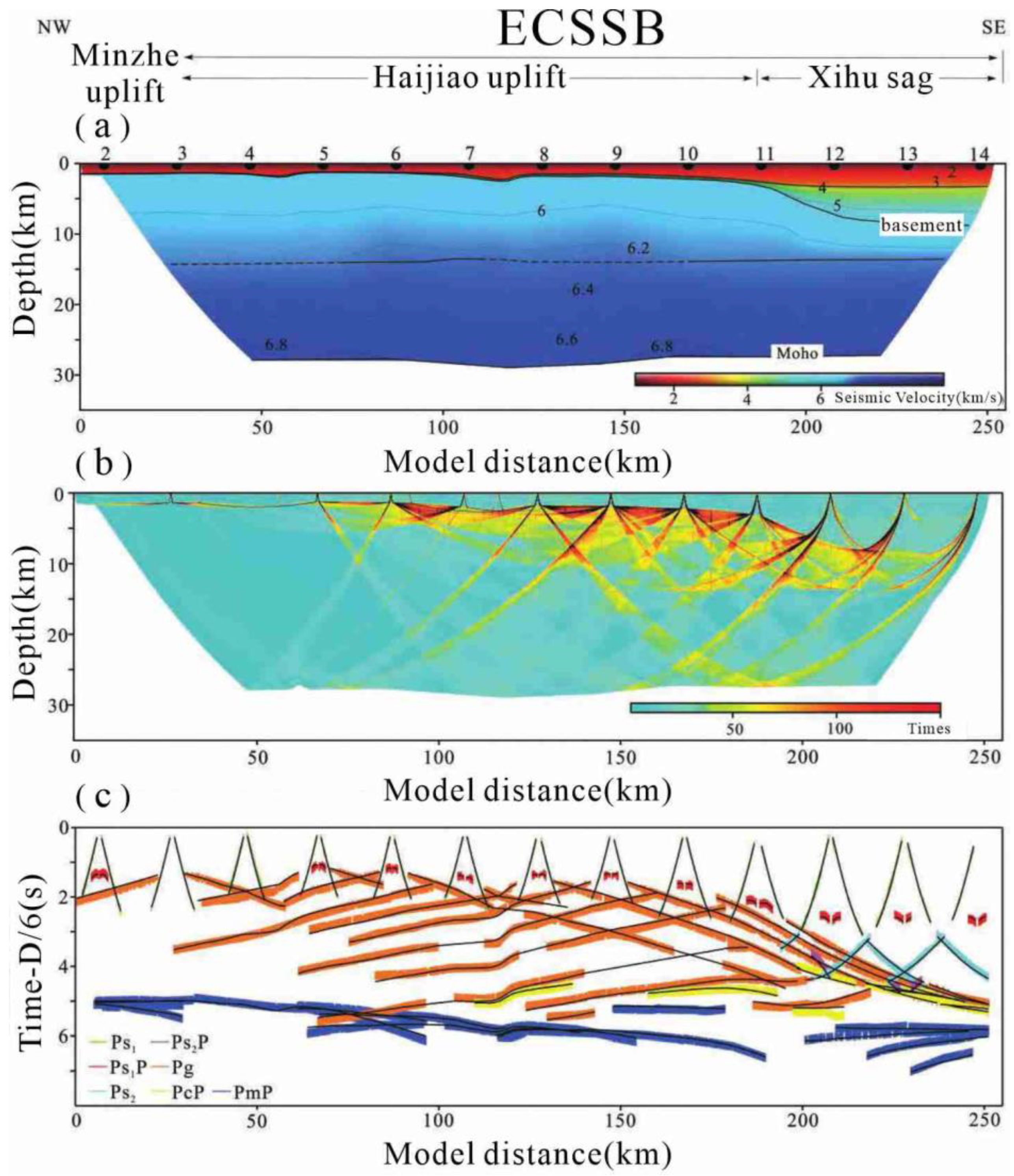
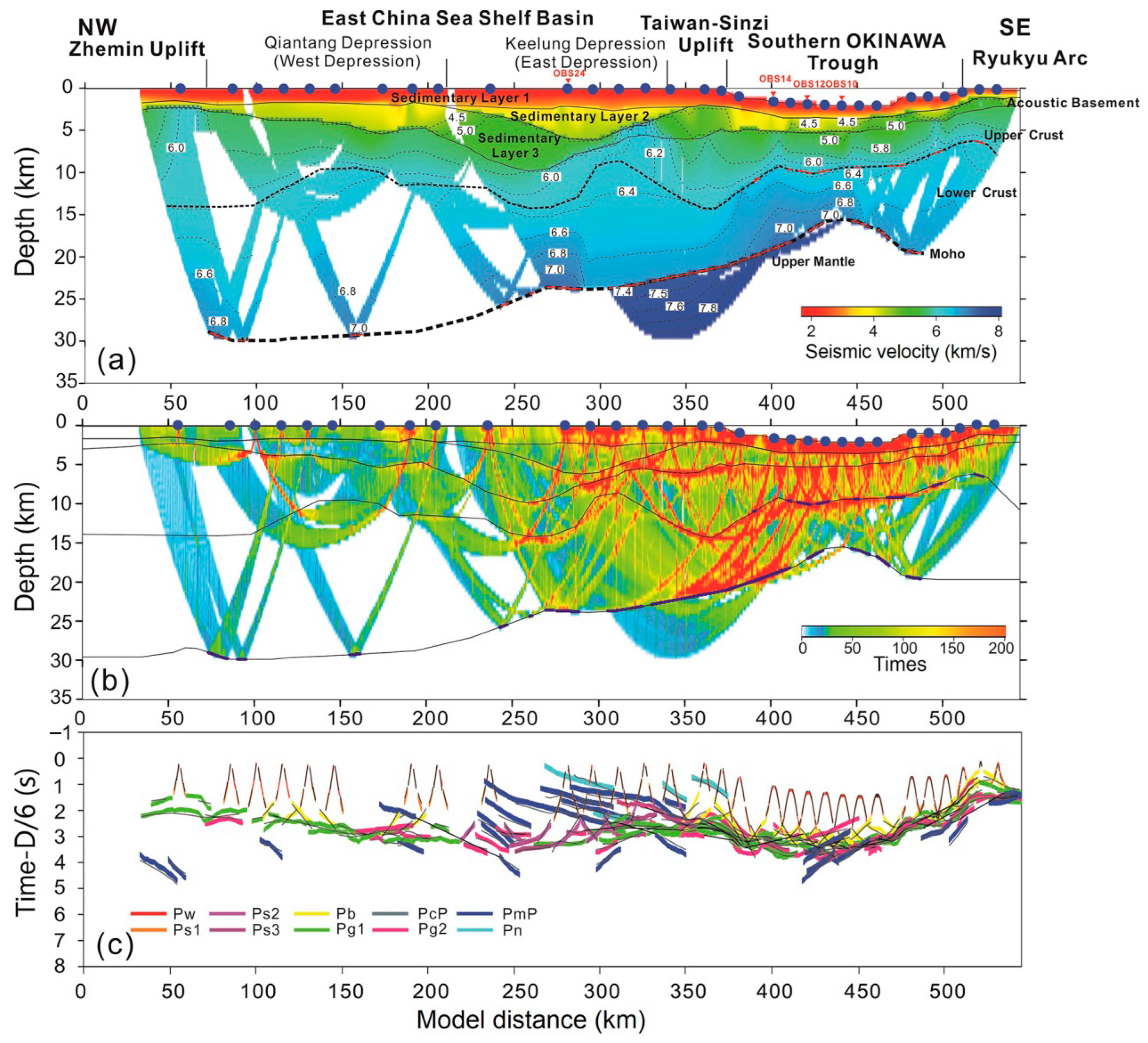
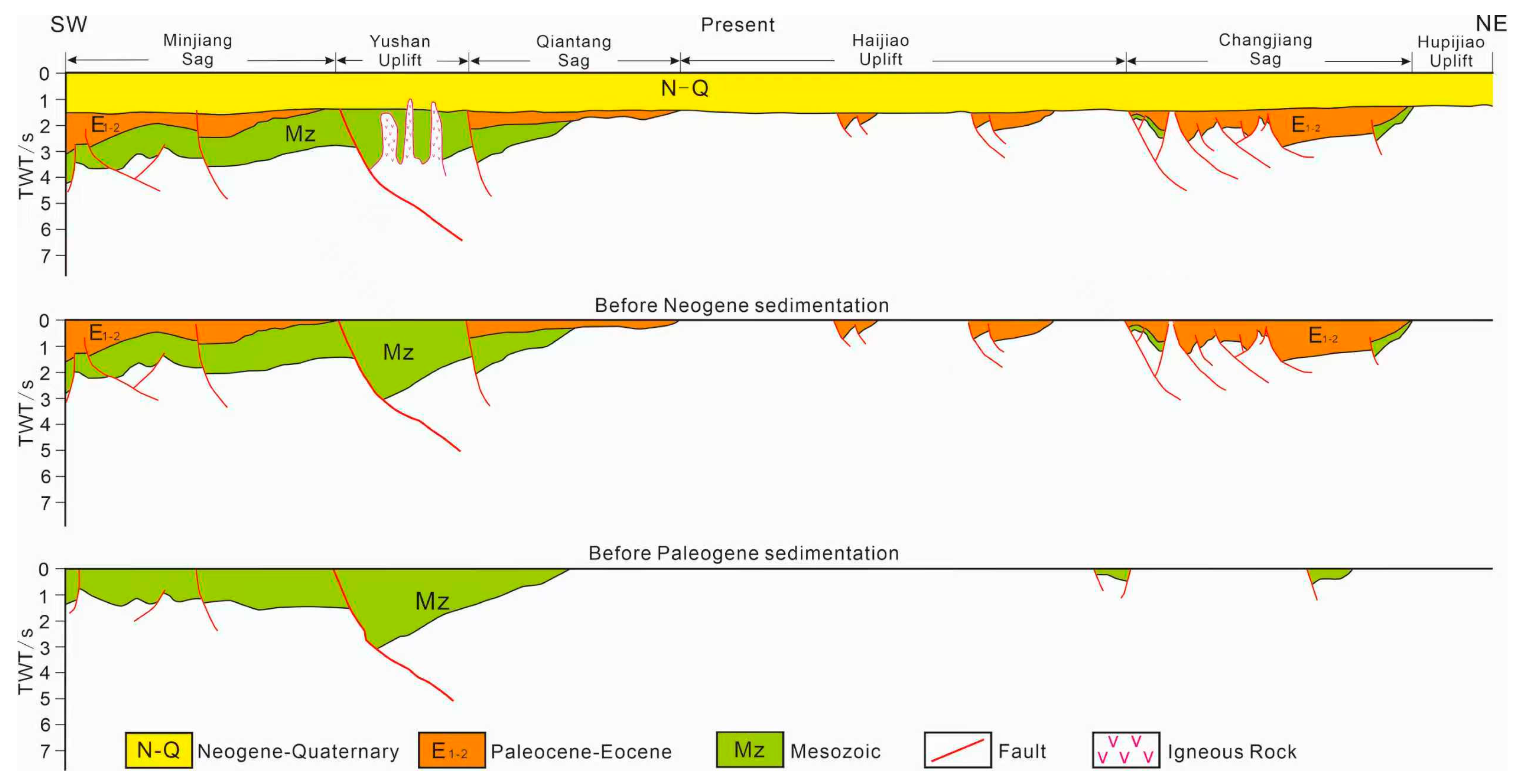
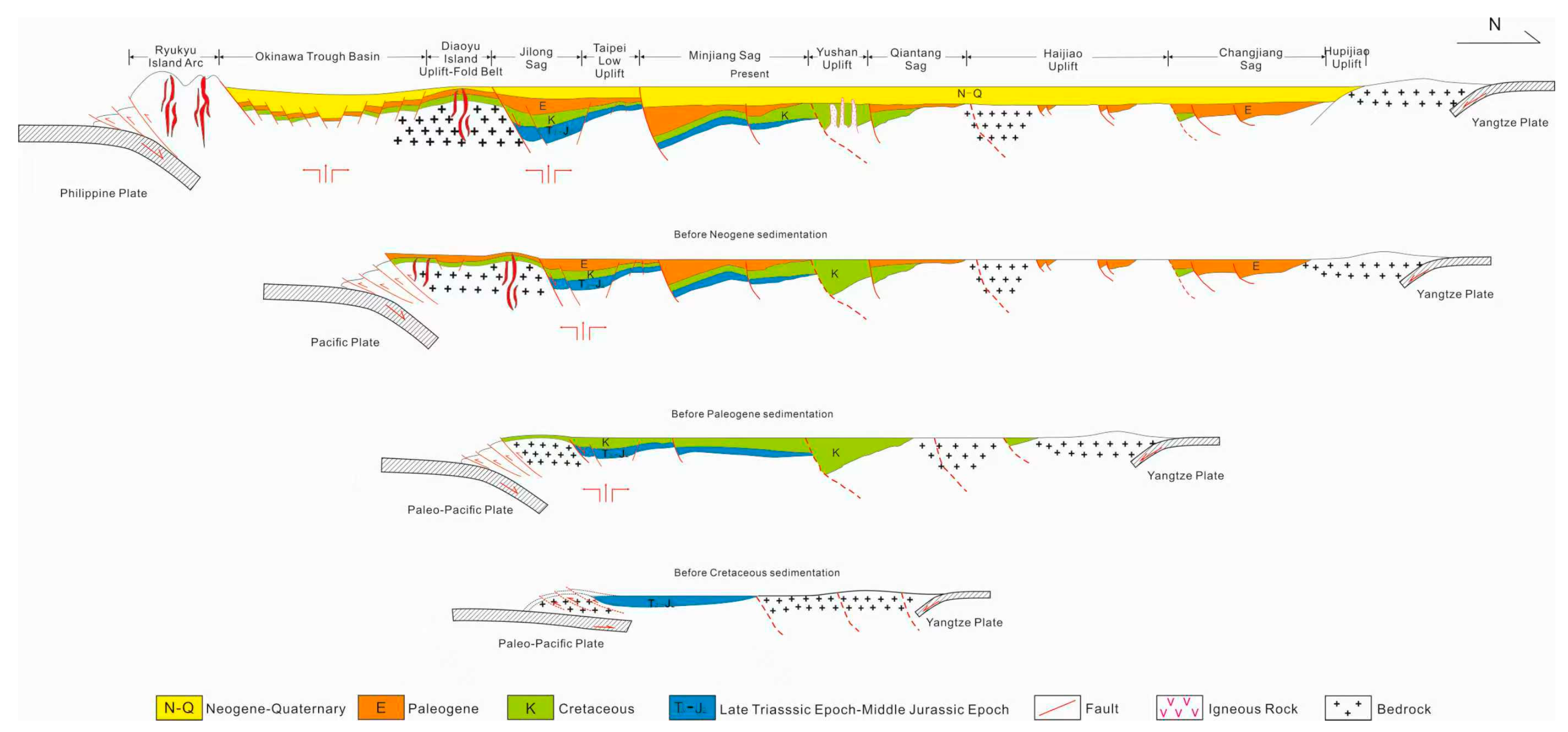
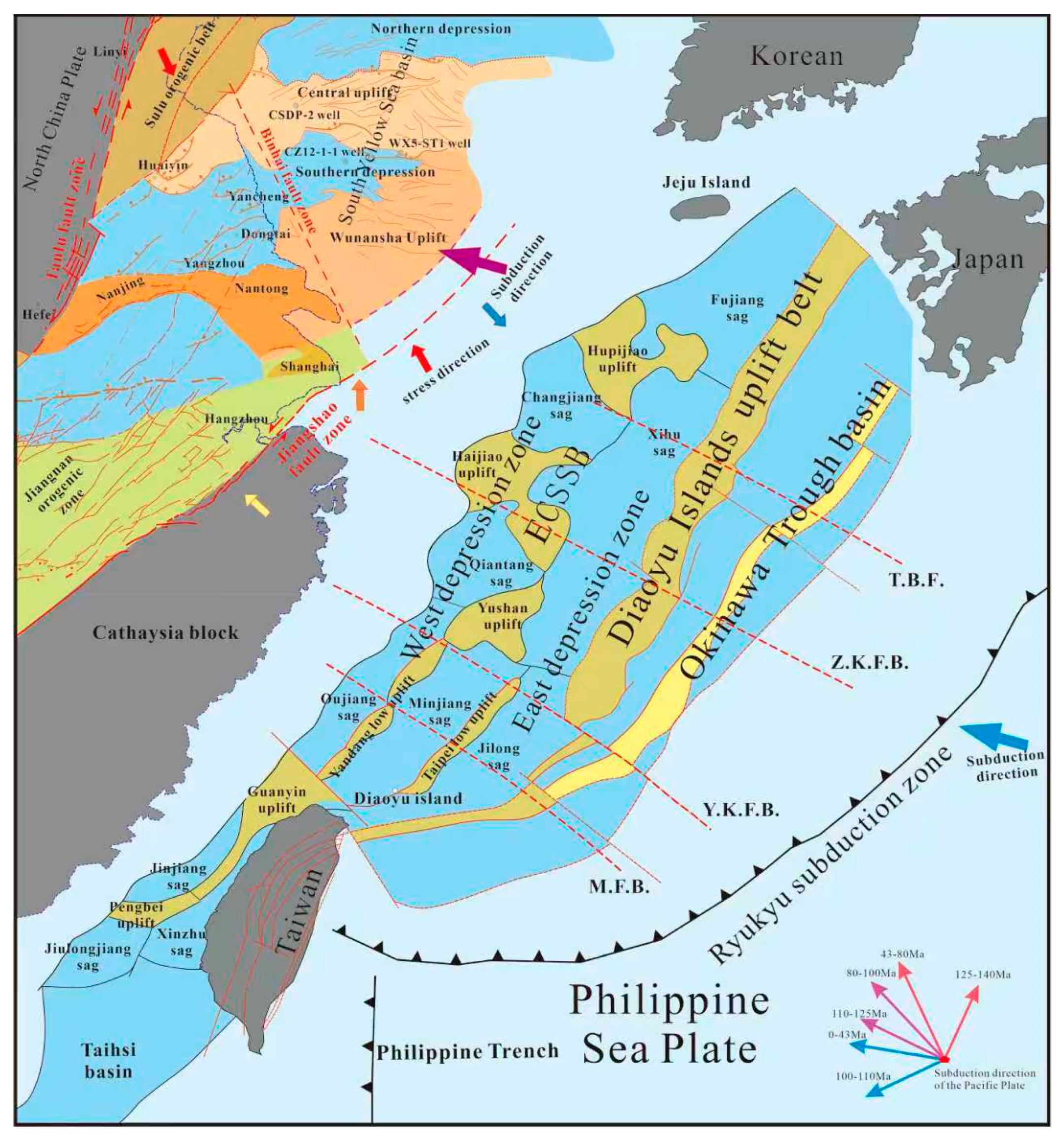
Disclaimer/Publisher’s Note: The statements, opinions and data contained in all publications are solely those of the individual author(s) and contributor(s) and not of MDPI and/or the editor(s). MDPI and/or the editor(s) disclaim responsibility for any injury to people or property resulting from any ideas, methods, instructions or products referred to in the content. |
© 2025 by the authors. Licensee MDPI, Basel, Switzerland. This article is an open access article distributed under the terms and conditions of the Creative Commons Attribution (CC BY) license (https://creativecommons.org/licenses/by/4.0/).
Share and Cite
Yang, C.; Song, J.; Yang, Y.; Shang, L.; Liao, J.; Zhou, Y. Differences in Mesozoic–Cenozoic Structural Deformation Between the Northern and Southern Parts of the East China Sea Shelf Basin and Their Dynamic Mechanisms. J. Mar. Sci. Eng. 2025, 13, 1809. https://doi.org/10.3390/jmse13091809
Yang C, Song J, Yang Y, Shang L, Liao J, Zhou Y. Differences in Mesozoic–Cenozoic Structural Deformation Between the Northern and Southern Parts of the East China Sea Shelf Basin and Their Dynamic Mechanisms. Journal of Marine Science and Engineering. 2025; 13(9):1809. https://doi.org/10.3390/jmse13091809
Chicago/Turabian StyleYang, Chuansheng, Junlan Song, Yanqiu Yang, Luning Shang, Jing Liao, and Yamei Zhou. 2025. "Differences in Mesozoic–Cenozoic Structural Deformation Between the Northern and Southern Parts of the East China Sea Shelf Basin and Their Dynamic Mechanisms" Journal of Marine Science and Engineering 13, no. 9: 1809. https://doi.org/10.3390/jmse13091809
APA StyleYang, C., Song, J., Yang, Y., Shang, L., Liao, J., & Zhou, Y. (2025). Differences in Mesozoic–Cenozoic Structural Deformation Between the Northern and Southern Parts of the East China Sea Shelf Basin and Their Dynamic Mechanisms. Journal of Marine Science and Engineering, 13(9), 1809. https://doi.org/10.3390/jmse13091809




